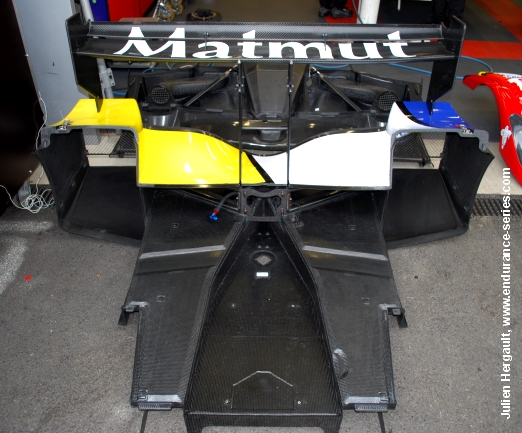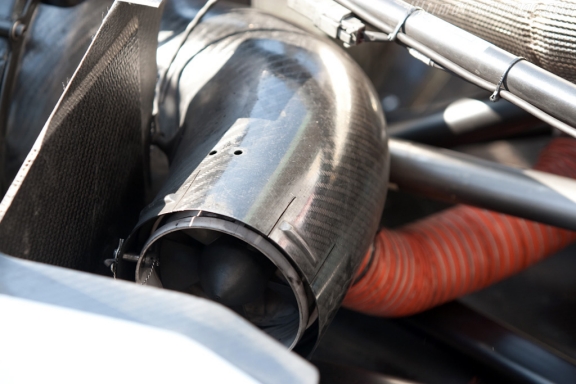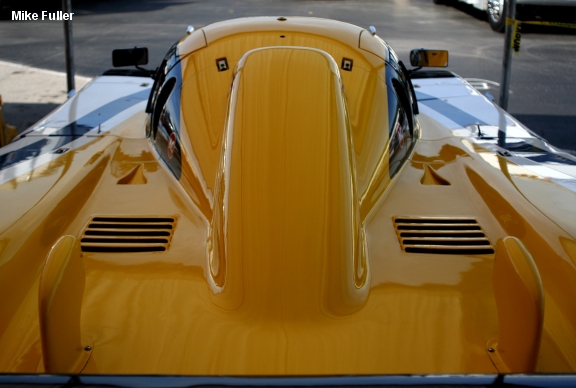May/June 2009
Reload to see the latest news
All news content copyright Michael J. Fuller, unless otherwise noted |
|

|
|
| >>Click here for Le Mans 2009 coverage<< |
6.30.09
Excuse
the appearance here of any lack of activity. Naturally, for the
Le Mans coverage click the link above. That will be hard wired
into the site at some point and linkable from the front page as a
permanent resource.
>>We're
following up a story from Le Mans and while there isn't much to really
discuss, it's a simple reminder that all is not over regarding the Audi
R15 design controversy. Recall that after the ACO denied Peugeot's challenge of technical details on the Audi R15,
Peugeot vowed to take the matter up with the FIA as part of their
right of appeal. So what happens next? While I'm hardly
familiar or particularly interested in the governing mechanics of all
of this, I have been asking around and this was the answer I received. So the process goes something like this: Peugeot's appeal moves to the Federation Francaise du Sport Automobile
(FFSA), which as we understand it is the national governing arm of the
FIA in France (similar to ACCUS' role in the United States). From
there it is expected to get bounced to
the FIA and a ruling made. This expected to get in motion by some
time late in July with outcomes of one sort or another around that
time. Now this process is moving forward, supposedly. But
there are precious few details coming out of the FIA such that there
are those within Audi who are in a position to know but haven't
the foggiest idea as to when this all will occur or even it if is moving forward. From others we're assured it is moving forward and to pay attention towards the end of July. |
5.29.09
 >>Audi has released a video
showing the R15 testing at Paul Ricard and in what we presume is the
car's 2009 Le Mans
guise. Though we understand this isn't the definitive
specification, that other (minor) changes will become evident when
the car arrives at Le Mans. And only one of those changes has
been driven by the ACO. >>Audi has released a video
showing the R15 testing at Paul Ricard and in what we presume is the
car's 2009 Le Mans
guise. Though we understand this isn't the definitive
specification, that other (minor) changes will become evident when
the car arrives at Le Mans. And only one of those changes has
been driven by the ACO.
We can see a revised rear wing endplate with a notch
removed from the upper leading edge in addition to a very aggressive
rear fender flip up. The rear overhang has been reduced. |
 The R15 now has a vent exiting the trailing edge of the wheel well. The R15 now has a vent exiting the trailing edge of the wheel well. |
 The exit on the nose vent has been reduced. The exit on the nose vent has been reduced. |  According
to Audi's Wolfgang Appel, the R15's crash structure consists of twin
cones either side of the nose. The space between these cones forms the
nose vent and with a little inspection (image below) we can surmise
that the entire center section of the nose is a hollow panel. This
panel forms the leading edge cap of the nose itself. It would be
reasonable
to believe that in Le Mans configuration, extending this panel's
trailing edge rearward
would reduce drag and compensate for the shift in aero balance given
the reduction in rear wing angle. According
to Audi's Wolfgang Appel, the R15's crash structure consists of twin
cones either side of the nose. The space between these cones forms the
nose vent and with a little inspection (image below) we can surmise
that the entire center section of the nose is a hollow panel. This
panel forms the leading edge cap of the nose itself. It would be
reasonable
to believe that in Le Mans configuration, extending this panel's
trailing edge rearward
would reduce drag and compensate for the shift in aero balance given
the reduction in rear wing angle. |  A
close up of the tow hook allows us to see that the hook itself is
mounted to the solid crash structure and that the area between the two
structures would appear to be hollow. A
close up of the tow hook allows us to see that the hook itself is
mounted to the solid crash structure and that the area between the two
structures would appear to be hollow. |
|
 | Inside IMSA's Legendary GTP Race Cars, The Prototype Experience
|
Get your copy today! Interested in purchasing a signed copy? Conrtact me. Limited quantities available.
|
|
|
5.18.09
| >>Aston Martin raced with a revised engine intake for the Spa
round of the Le Mans Endurance Series. The primary difference
that we can see is that a spacer panel has been bolted to
the lower half of the engine intake breaking up the appearance that the
intake was raised off the surface of the roof. One can't help but
wonder if the ACO has spoken with Aston regarding Art 3.4.5.
Of
course this spacer panel does little to integrate the engine
intake into the curved line of the roof. Conventional
wisdom on pitlane takes "integrated" to mean that in side view, the engine intake
should not project beyond the profile of the greenhous/cockpit. The key part of the phrase being, "...integrated into the curved line of the roof."
Without the portion, "curved line of the roof", what Aston has done
would suffice. But as the ACO has accepted Aston's
modifications, a "resetting" of the regulation's meaning and execution
is in order. |
|
 5.13.09 5.13.09
>>Thanks to Julien Hergault of the website Endurance-Series,
we've received images of just about every conceivable angle of the
Oreca LMP1's rear diffuser and...clearly nothing "trick" of the sort.
Chalk it up to a miscommunication. |
 5.9.09 5.9.09
>>At
the first Le Mans Series race at Barcelona, the Lola Aston Martin was
spotted using rear fans as the primary source for brake cooling
airflow. These images come courtesy Wouter Melissen's Ultimatecarpage.com website. |
 The
ducts, with fans inside, pointed rearward. They bolted onto the
upright and simply drew the cooling air in through the
upright/wheel center. The
ducts, with fans inside, pointed rearward. They bolted onto the
upright and simply drew the cooling air in through the
upright/wheel center.
Wouter Melissen tells
us that the ducts and fans are missing this weekend at the Spa Le Mans
Series round, instead replaced by traditional NACA inlet ducts.
One wonders if the ACO had second thoughts given Article 1.5.3:
Movable bodywork parts/elements are forbidden when the car is in motion.
Melissen
also has indicated that the new Oreca LMP1 is using a Formula One style
"double decker" rear diffuser. For now we're waiting on images so
were only speculating for the moment.
The rise of the
double decker diffusers in F1 came about because of vague regulations
written regarding the size and function of holes within the regulated
flat bottom area of the diffuser. Brawn et al put holes in the
vertical face of the stepped bottom and then crafted an upper diffuser
section utilizing the rear crash structure and surrounding bodywork.
ACO regulations are rather more specific about what holes can be
in the underbody for an LMP with Article 3.5 stating:
The only openings permitted are the minimum gaps necessary for wheel and suspension part movements (suspension travel and steering), air jack holes, sensors for measuring the ground clearance (LMP1 only), closed hatches (maintenance operations) and the overflow fuel pipe.
We
suppose one could mount the air jacks in the vicinity of the
bellhousing such that where they pierced the underfloor was in the
vertical face of the regulated rear boat tail structure. Then you
could utilize those holes to duct air over the top of the regulated
diffuser and out the back of the car. But would the ACO allow
that? |
|
5.8.09
>>Some on-track shots of the Group 44 Jaguar XJR-7-005 courtesy of Chuck Anderson.
|
|
5.5.09
 >>I
attended this year's Walter Mitty Historic Sportscar Racing
event here at Road Atlanta this past weekend. The
featured marque was Group 44; Bob Tullius' various racing
Jaguars. >>I
attended this year's Walter Mitty Historic Sportscar Racing
event here at Road Atlanta this past weekend. The
featured marque was Group 44; Bob Tullius' various racing
Jaguars. |
 Group
44 Jaguar XJR-7, the so called "Mag Jag" or "Magnum 44." This car
was built on chassis # XJR-7-005, though the car is known as an XJR-8. Group
44 Jaguar XJR-7, the so called "Mag Jag" or "Magnum 44." This car
was built on chassis # XJR-7-005, though the car is known as an XJR-8.
Tim Pendergast sends in a few more details:
"...XJR-7/005...raced once,
at the 1987 SunBank 24 at Daytona. Drivers were Tullius/Hurley Haywood and
John Morton. The car was a DNF with an engine failure. After that,
they started to rework the bodywork on the car. Also, knowing the contract
with Jaguar was not going to be renewed, they re-engineered the car to accept a
Chevy V-8. The name 44 Magnum was picked as the car had a 7.0 liter
magnesium block V-12 motor installed. Was one of only 3 of these motors
that were built by Jaguar. A new motor is in the car now, as the fluids
were left in it from the last time it ran in 1995 and the magnesium has corroded
beyond repair. Basically, everything under the bodywork is
XJR-7." |
 Only one Porsche 962 was present this year. Only one Porsche 962 was present this year. |
 Porsche
962-119 is an ex-BF Goodrich Team Busby car. From what I can
gather, chassis 962-119 debuted in 1986, though no source agrees on
which event exactely. It raced on and off through 1989.
It's last event appears to have been the 1989 Tampa World
Challenge race. Oddly, Peter Morgan's 956/962 book claims the chassis
was "disliked by drivers." 962-119 ended its career as a show
car. Porsche
962-119 is an ex-BF Goodrich Team Busby car. From what I can
gather, chassis 962-119 debuted in 1986, though no source agrees on
which event exactely. It raced on and off through 1989.
It's last event appears to have been the 1989 Tampa World
Challenge race. Oddly, Peter Morgan's 956/962 book claims the chassis
was "disliked by drivers." 962-119 ended its career as a show
car. |
 Kaput Corvair. Kaput Corvair. |
 Maserati 300S, 1955. Maserati 300S, 1955. |
 Group 44 Jaguar
XJR-5-007. #007's history is pretty extensive. According to
Pendergast, chassis #007 debuted at Road Atlanta in 1984 qualifying 4th
but dnf'ing with brake failure. Group 44 Jaguar
XJR-5-007. #007's history is pretty extensive. According to
Pendergast, chassis #007 debuted at Road Atlanta in 1984 qualifying 4th
but dnf'ing with brake failure. |
1984, XJR-5-007
| Race | Qualifying | Finish | | Road Atlanta | 4th | DNF (brakes) | | Charlotte | 5th | 2nd | | Watkins Glen 3 Hour | 4th | DNF (crash) | | Skipped Portland and Sears Point | | | | Road America | 5th | 5th | | Skipped Portland and Michigan | | | | Watkins Glen NY500 | 4th | DNF (crash) | | Skipped Daytona finale | | |
| 1985, XJR-5-007
| Race | Qualifying | Finish | | Daytona 24 | 8th | DNF (tire failure and fire) | | Skipped Miami | | | | Sebring | 7th | DNF (engine) | | Road Atlanta | 5th | 2nd | | Riverside | 5th | 3rd | | Laguna Seca | 7th | 3rd | | Charlotte | 6th | 4th | | Lime Rock | 3rd | 6th | | Skipped Le Mans | | | | Watkins Glen | 6th | DNF (ring & pinion) |
|
|
 |  | Aerodynamicist
and automotive enthusiast Paul T. Glessner presents "The Secrets
&
Basics of Vehicle Aerodynamics" Seminars. See why more cars
are going
faster and doing it more safely and in style. Paul has been
asked
to speak at venues like Bob Bondurant School of High Performance
Driving,
Society of Automotive Engineers (SAE), Specialty Equipment Marketing
Assoc.
(SEMA), and Performance Racing Industry (PRI). Paul's
seminars both
educate and entertain. The day long seminar can be held at
your club,
organization and/or company location with the organizer paying only
$100.
(click event date in site) to read
about Paul's
extensive background and testimonials from enthusiasts like Jay
Leno.
Schedule your seminar at www.aeroseminars.com! | |
"While
I am not an engineer or a major technical type, I enjoy the discipline
of aerodynamics and was pleased at how Paul was able to explain its
intricacies
to individuals like me." - Jay Leno, Tonight Show Host |
|

